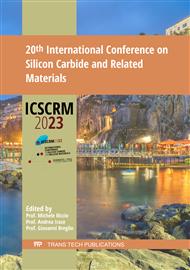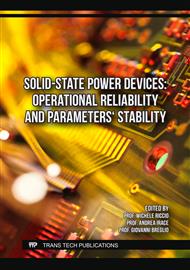p.1
p.7
p.13
p.21
p.27
p.33
p.39
p.47
Dependence of the Silicon Carbide Radiation Resistance on the Irradiation Temperature
Abstract:
The effect of high-temperature electron and proton irradiation on SiC-based device characteristics is being investigated. Industrial integrated 4H-SiC Schottky diodes, each with an n-type base and a blocking voltage of either 600 V, 1200 V, or 1700 V, manufactured by Wolfspeed, are being studied. 0.9 MeV electron and 15 MeV proton irradiation were applied. It has been found that the irradiation resistance of silicon carbide Schottky diodes at high temperatures significantly exceeds their resistance at room temperature. This effect is attributed to the annealing of compensating defects induced by high-temperature irradiation. The parameters of radiation-induced defects are determined using the method of deep level transient spectroscopy (DLTS). Under high-temperature ("hot") irradiation, the spectrum of radiation-induced defects introduced into SiC appears to differ significantly from the spectrum of defects introduced at room temperature. It is suggested that approximately half of the compensation is due to radiation-induced defects formed in the bottom part of the bandgap.
Info:
Periodical:
Pages:
21-25
Citation:
Online since:
August 2024
Permissions:
Share:
Citation:



